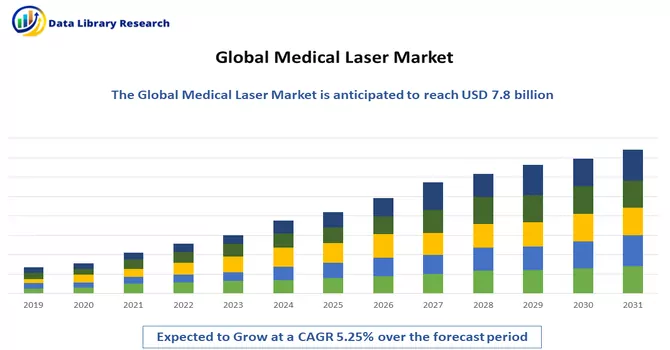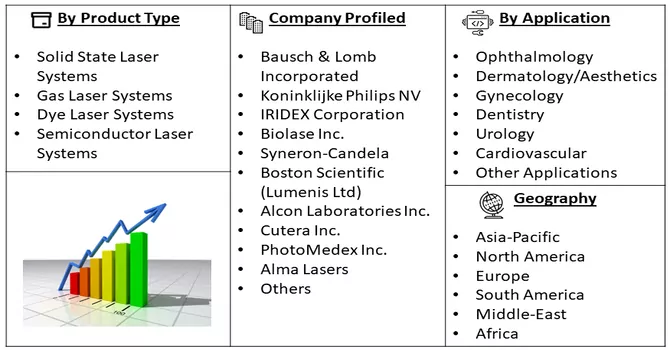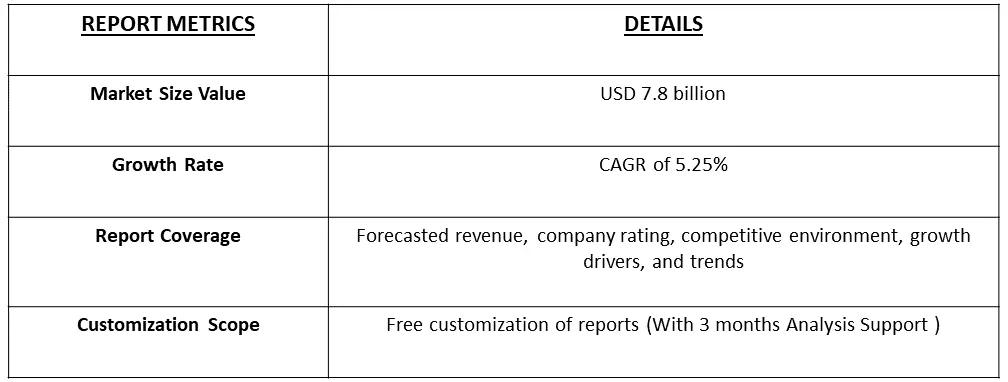The Medical Laser Systems Market is currently valued at USD 7.8 billion and is expected to growth at a CAGR of 5.25% over the forecast period.

Get Complete Analysis Of The Report - Download Free Sample PDF
A medical laser is a highly focused beam of light that is utilized in various medical procedures and treatments. This technology harnesses the principles of amplification of light through stimulated emission of radiation to produce a concentrated and precise energy source. Medical lasers find applications in a wide range of medical fields, including surgery, dermatology, ophthalmology, and dentistry. The controlled and targeted nature of laser beams allows for minimally invasive procedures, enabling surgeons and healthcare professionals to perform precise tissue ablation, coagulation, and other therapeutic interventions with reduced damage to surrounding tissues. Medical lasers have become integral tools in modern medicine, offering enhanced precision, efficiency, and therapeutic outcomes in a diverse array of medical applications.
The Medical Laser Market is driven by several key factors that contribute to its sustained growth and prominence in the healthcare industry. Firstly, the increasing prevalence of chronic diseases and the growing aging population worldwide have led to a rising demand for minimally invasive and precise medical procedures, where medical lasers play a crucial role. Additionally, advancements in laser technology have enabled the development of more sophisticated and specialized medical laser systems, expanding their applications across various medical disciplines, including surgery, dermatology, ophthalmology, and dentistry. The continuous research and development activities in the field have resulted in the introduction of innovative laser-based therapies and treatments, further propelling market growth.
Market Segmentation: The Medical Laser Market is Segmented by Product Type (Solid State Laser Systems, Gas Laser Systems, Dye Laser Systems, and Semiconductor Laser Systems), Application (Ophthalmology, Dermatology/Aesthetics, Gynecology, Dentistry, Urology, Cardiovascular, Other Applications), and Geography (North America, Europe, Asia-Pacific, Middle East and Africa, and South America). The report offers the value (in USD million) for the above segments.

For Detailed Market Segmentation - Download Free Sample PDF
The Medical Laser Market is witnessing several notable trends that shape its trajectory and influence industry dynamics. One prominent trend is the growing preference for aesthetic and cosmetic laser procedures, driven by an increasing focus on non-invasive treatments for skin rejuvenation, hair removal, and tattoo removal. Advancements in laser technology have led to the development of more versatile and targeted devices, catering to a diverse range of aesthetic applications. Another significant trend is the rise of laser-based diagnostic and imaging technologies, offering non-invasive and real-time monitoring of various medical conditions. Moreover, the integration of artificial intelligence (AI) and machine learning into medical laser systems is enhancing their precision and customization, optimizing treatment outcomes. The market is also witnessing a shift towards portable and compact laser devices, promoting accessibility and flexibility in healthcare settings.
Market Drivers:
Rising Preference for Minimally Invasive Procedures
The rising preference for minimally invasive procedures has emerged as a significant driver in the growing adoption of medical lasers across various healthcare disciplines. Patients and healthcare professionals alike are increasingly opting for procedures that minimize trauma, reduce scarring, and hasten recovery times. Medical lasers, with their precise and controlled tissue interaction, have become instrumental in fulfilling this demand. In surgeries ranging from dermatological interventions to ophthalmic procedures, medical lasers offer a less invasive alternative to traditional surgical methods. The use of laser technology allows for pinpoint accuracy in tissue ablation, coagulation, and incision, minimizing collateral damage to surrounding healthy tissues. This trend aligns with the broader shift toward outpatient and day-care procedures, where the reduced downtime associated with laser treatments contributes to patient convenience. The versatility of medical lasers in providing effective solutions for various conditions while maintaining a minimally invasive approach underscores their pivotal role in modern healthcare, reflecting a paradigm shift towards patient-centric, efficient, and less intrusive medical interventions.
Increasing Burden of Eye Disorders
The increasing burden of eye disorders has propelled the integration of medical lasers as a crucial component in ophthalmic care. With the global prevalence of conditions such as cataracts, glaucoma, and retinal disorders on the rise, the demand for effective and precise treatment options has surged. Medical lasers, particularly in the field of ophthalmology, have proven to be indispensable tools for various procedures. Laser technologies, such as photocoagulation and photodisruption, are commonly employed in the treatment of conditions like diabetic retinopathy, macular degeneration, and glaucoma. One notable application is in refractive surgery, where laser-assisted procedures like LASIK (Laser-Assisted In Situ Keratomileusis) have gained popularity for correcting vision impairments, reducing dependence on eyeglasses or contact lenses. Additionally, medical lasers are utilized in procedures such as cataract surgery, where advanced femtosecond lasers assist in creating precise incisions and breaking down the cloudy lens, contributing to improved surgical outcomes. The use of medical lasers in ophthalmology aligns with the demand for minimally invasive interventions, as laser treatments often result in quicker recovery times and reduced postoperative complications. As the prevalence of eye disorders continues to increase, the role of medical lasers in providing efficient, safe, and targeted solutions becomes increasingly prominent, contributing to the evolution of eye care practices and enhancing the quality of vision-related treatments.
Market Restraints:
Stringent Regulatory Compliance
The medical sector operates within a framework of stringent regulatory standards, and ensuring adherence to diverse regulatory bodies poses a multifaceted and time-intensive challenge. Manufacturers encounter difficulties not only in initially meeting but also in consistently maintaining compliance with these standards. The introduction of new regulations or modifications to existing standards can markedly hinder the approval process for medical laser products, leading to delays. These delays not only impede the timely introduction of products to potential customers but also have the potential to slow the overall growth trajectory of the market under scrutiny. The complex and dynamic nature of regulatory compliance in the medical sector underscores the need for manufacturers to stay agile and proactive in adapting to evolving standards to navigate the intricate landscape of product approvals and market access.
The COVID-19 pandemic has introduced a dual impact on the Medical Laser Market. On one hand, the disruption of routine healthcare services due to lockdowns and resource reallocation led to a temporary slowdown in the adoption of medical laser technologies for elective procedures. However, the pandemic underscored the importance of medical lasers in critical applications, particularly in facilitating minimally invasive and efficient diagnostic and therapeutic procedures. As healthcare adapted to the new normal, the precision and versatility of medical lasers became essential for addressing evolving needs, such as remote healthcare solutions and reduced in-person interactions. The increased focus on healthcare infrastructure and technology investments globally suggests potential long-term growth opportunities for the Medical Laser Market as the industry continues to adapt and recover from the challenges posed by the pandemic.
Segmental Analysis:
Solid State Laser Systems Segment is Expected to Witness Significant growth over the Forecast Period
Solid-state laser systems represent a significant leap in laser technology, featuring a design that utilizes a solid medium, often crystals or glass, for generating coherent and potent laser beams. Renowned for their compactness, reliability, and increased efficiency compared to traditional gas or liquid lasers, solid-state lasers have found applications in diverse industries. In medicine, these lasers are extensively employed for precise tasks like tissue ablation, coagulation, and various surgical procedures across fields such as dermatology, ophthalmology, and dentistry. They also play a crucial role in cosmetic procedures like tattoo removal and skin resurfacing. In manufacturing, solid-state lasers are pivotal for cutting, welding, and marking materials such as metals and plastics, contributing to advancements in precision machining. Furthermore, their high-energy output and compact size make solid-state lasers valuable components in directed energy weapons for defense applications, facilitating target tracking, range-finding, and threat disablement. As ongoing research continues to enhance their performance, solid-state laser systems are poised to further drive innovations, demonstrating their versatility and efficiency across a wide range of industries and solidifying their status as integral components in modern technological advancements. Thus, such factors are expected to drive the growth of the studied market over the forecast period.
Ophthalmology Segment is Expected to Witness Significant growth over the Forecast Period
Ophthalmology has witnessed transformative advancements with the integration of medical laser technology, revolutionizing the diagnosis and treatment of various eye conditions. Medical lasers have become indispensable tools in ophthalmic practice, offering precision and effectiveness in addressing a spectrum of disorders. In refractive surgery, procedures like LASIK (Laser-Assisted In Situ Keratomileusis) have gained prominence, providing patients with an alternative to traditional vision correction methods. Lasers are extensively used for vision-correcting surgeries, reshaping the cornea to improve visual acuity and reduce dependence on glasses or contact lenses. Additionally, medical lasers play a crucial role in treating retinal conditions, such as diabetic retinopathy and macular degeneration, through procedures like laser photocoagulation. Their ability to precisely target and treat specific areas of the eye makes them valuable in managing conditions like glaucoma by facilitating effective intraocular pressure reduction. The non-invasive nature of many laser procedures in ophthalmology contributes to quicker recovery times and reduced postoperative complications, aligning with the growing preference for minimally invasive interventions. As ophthalmology continues to evolve, the integration of medical lasers not only enhances the accuracy and efficacy of treatments but also underscores their pivotal role in shaping the landscape of eye care, providing patients with advanced and less invasive solutions for various vision-related conditions. Thus, such factors are expected to drive the growth of the studied market over the forecast period.
North America Region is Expected to Witness Significant growth over the Forecast Period
North America is poised for substantial growth, driven by several factors including a surge in demand for aesthetic procedures, continuous product approvals and launches, and a high concentration of market players in the region. The increasing popularity of cosmetic procedures is anticipated to significantly contribute to the demand for medical lasers in the foreseeable future. Notably, the Aesthetic Plastic Surgery National Databank's 2021 report revealed a remarkable 55% growth in the performance of skin treatments using combination lasers in the United States, totaling 431.5 thousand procedures in 2021. Furthermore, market dynamics were influenced by key product launches, such as the introduction of the next-generation Clear + Brilliant laser by Solta Medical in March 2021. This laser, equipped with advanced features, offers a more tailored and comprehensive treatment protocol, incorporating benefits from two wavelengths. Similarly, Alma's FDA 510(k) clearance for Alma Hybrid, integrating both ablative and non-ablative lasers for skin resurfacing, and the launch of Acclaro Corporation's UltraClear laser technology system in April 2022, further highlight the region's commitment to advanced and innovative laser solutions. The collective impact of these factors positions North America as a significant growth hub in the medical laser market, fueled by the increasing demand for cosmetic procedures and the continuous introduction of cutting-edge laser technologies.

Get Complete Analysis Of The Report - Download Free Sample PDF
The medical laser market is characterized by the presence of several major players that contribute significantly to its competitive landscape. These industry leaders are renowned for their innovation, technological expertise, and diverse product portfolios catering to various medical applications. Companies such as Lumenis Ltd., Cynosure (a subsidiary of Hologic Inc.), Alma Lasers, El.En. S.p.A. (DEKA), and Biolitec AG are among the prominent players shaping the trajectory of the medical laser market. These companies engage in strategic initiatives such as mergers and acquisitions, product launches, and collaborations to strengthen their market position and expand their offerings. With a focus on research and development, these key players continuously strive to introduce cutting-edge technologies, ensuring a robust and dynamic market that meets the evolving needs of healthcare professionals and patients alike. The competition among major players in the medical laser market underscores the industry's commitment to innovation and advancements in medical laser technologies. Some of the key market players are:
Recent Development:
1) In November 2023: Sisram Medical Ltd's subsidiary, Alma Lasers, opened a new branch in Tokyo, marking its sixth subsidiary in Asia Pacific. This strategic move is poised to contribute to the expansion of the medical laser market in Japan and the broader Asia Pacific region. Alma's cutting-edge product portfolio, including flagship energy-based devices, aims to enhance medical and aesthetic offerings, aligning with Sisram's commitment to a diverse consumer wellness ecosystem.
2) In July 2023, Alma, a renowned global leader in the energy-based medical and aesthetic solutions industry, launched Alma Veil. This advanced vascular laser workstation, featuring dual-wavelength technology, set a new standard in excellence by optimizing efficiency and demonstrating remarkable efficacy across a comprehensive range of vascular and dermatological conditions.
Q1. What was the Medical Laser Systems Market size in 2023?
As per Data Library Research the Medical Laser Systems Market is currently valued at USD 7.8 billion.
Q2. At what CAGR is the Medical Laser Systems market projected to grow within the forecast period?
Medical Laser Systems market is expected to growth at a CAGR of 5.25% over the forecast period.
Q3. What are the factors driving the Medical Laser Systems market?
Key factors that are driving the growth include the Rising Preference for Minimally Invasive Procedures and Increasing Burden of Eye Disorders
Q4. Which region has the largest share of the Medical Laser Systems market? What are the largest region's market size and growth rate?
North America has the largest share of the market. For detailed insights on the largest region's market size and growth rate request a sample here.
Data Library Research are conducted by industry experts who offer insight on industry structure, market segmentations technology assessment and competitive landscape (CL), and penetration, as well as on emerging trends. Their analysis is based on primary interviews (~ 80%) and secondary research (~ 20%) as well as years of professional expertise in their respective industries. Adding to this, by analysing historical trends and current market positions, our analysts predict where the market will be headed for the next five years. Furthermore, the varying trends of segment & categories geographically presented are also studied and the estimated based on the primary & secondary research.
In this particular report from the supply side Data Library Research has conducted primary surveys (interviews) with the key level executives (VP, CEO’s, Marketing Director, Business Development Manager and SOFT) of the companies that active & prominent as well as the midsized organization
FIGURE 1: DLR RESEARH PROCESS

Extensive primary research was conducted to gain a deeper insight of the market and industry performance. The analysis is based on both primary and secondary research as well as years of professional expertise in the respective industries.
In addition to analysing current and historical trends, our analysts predict where the market is headed over the next five years.
It varies by segment for these categories geographically presented in the list of market tables. Speaking about this particular report we have conducted primary surveys (interviews) with the key level executives (VP, CEO’s, Marketing Director, Business Development Manager and many more) of the major players active in the market.
Secondary ResearchSecondary research was mainly used to collect and identify information useful for the extensive, technical, market-oriented, and Friend’s study of the Global Extra Neutral Alcohol. It was also used to obtain key information about major players, market classification and segmentation according to the industry trends, geographical markets, and developments related to the market and technology perspectives. For this study, analysts have gathered information from various credible sources, such as annual reports, sec filings, journals, white papers, SOFT presentations, and company web sites.
Market Size EstimationBoth, top-down and bottom-up approaches were used to estimate and validate the size of the Global market and to estimate the size of various other dependent submarkets in the overall Extra Neutral Alcohol. The key players in the market were identified through secondary research and their market contributions in the respective geographies were determined through primary and secondary research.
Forecast Model
